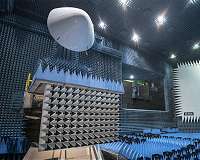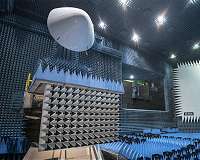ESA’s largest antenna test facility stays operational despite the COVID-19 pandemic, doing pre-flight testing for the satellite in a constellation to function the internet of things.
“The principal change from a normal test effort is that contact between people has been minimised, to fulfil social distancing needs,” states antenna test engineer Eric Van Der Houwen.
“So the clients came here to mount their nanosatellite inside the room, then hammered – normally they would remain around for the length.
“And I’m working in my own in the facility for the most part, interacting remotely with my colleague Alfredo. When I do want help in person, for instance to examine something, or shift a heavy item, then a colleague drops by: the pair people wear masks keep our distance as much as possible.”
Antenna engineer Alfredo Catalani is overseeing Eric through the effort:”I have stranded in Italy from the COVID-19 pandemic, but I’m ready to work remotely precisely the same. I get test data for post-processing. Eric serves sending photos of this test setup to me; if I want another view angle I simply ask for it.
“We are testing the performance of a total of six antennas aboard the nanosatellite, to validate that they’ll operate securely together in orbit. The business has supplied simulated antenna performance data, and our task is to compare this from the actual operation, and highlight any differences if they emerge”
Dutch distance company Hiber is building an orbital constellation of CubeSats – little modular satellites predicated around 10 cm components – to present international low-cost connectivity for its’internet of things’, tracking and exploiting information from modem-linked items like haulage vehicles, power wires, pipelines or sensors for precision agriculture.
The hybrid character of hertz makes it unique: the centre can assess radio signals from antennas either to a local’near-field’ foundation or as if the signal has crossed thousands of kilometres of distance, letting it function all sorts of antenna systems and satellites.
Hiber is coming to Hertz, using previously used the centre. “We are performing near-field measurements of this 30-cm-long CubeSat, with its various antennas in close proximity,” adds Alfredo.
“The principal UHF antenna – a self-deployable helix – for transmitting and receiving data to and from modems on the ground must operate well along with added UHF and VHF antennas for’telemetry, telecommand and control’ signs to the satellite platform, and S-band patch antennas for data handling. An extra GPS receiver antenna is going to be fitted before launching.”
The business is called’Hiber’ because its terminals hibernate most of the time, turning when a Hiber satellite passes to status updates and relay positioning. Hiber’s CubeSats are being fabricated for the business by Dutch satellite specialist ISIS-Innovative Solutions In Space.
“I’m glad that despite its Covid-19 steps ESTEC has been able to schedule and perform these evaluations,” remarks Bert Meijvogel of the Netherlands Space Office. “This is a significant pre-launch landmark for HiberThree, absolutely vital for predicting its internet of things service performance.”
– Advertisement –


